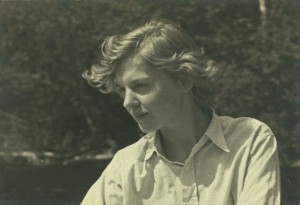By Leigh Beadon
Mutual friends arranged that we meet in a respectable downtown restaurant in Toronto. She wore a black, crushed velvet jump suit and a sultry pink tam over hair that was still thick and blonde nearing 70. She stole the wine glasses
That’s how Roy MacGregor described Elizabeth Smart in an Ottawa Citizen column published shortly after her death in 1986. Like many who had met her, he could not claim to know her well, but he found every glimpse of her personality captivating. This was Elizabeth Smart’s way —not just with people, but also with places. Though the Annex only knew her for a year near the end of her life, she made her mark on the neighbourhood as she did on all the places she visited in her extensive travels.
Elizabeth Smart is best known as the author of By Grand Central Station I Sat Down and Wept, a poetic story based on her affair with English poet George Barker, the father of her four children.
It was famously described by literary critic Brigid Brophy as one of the “half a dozen masterpieces of poetic prose in the world,” and has remained popular since it was first published in 1945. Smart published a handful of other poetry collections and prose pieces throughout her life, but none would achieve the same degree of fame. Smart’s true poem was her life, which she lived without reserve.
That life would take her from her birth in Ottawa in 1913, to countless places around the world, first as part of her job as a travelling secretary and later in pursuit of George Barker, with whom she fell in love after reading a book of his poems.
It wasn’t until 1983 that she moved to Toronto on a Canada Council writer’s grant and settled in the Annex.
Rosemary Sullivan is the Director of the M.A. Creative Writing Program at the University of Toronto, and wrote the 1991 Smart biography By Heart. A long-time author of fiction and non-fiction, she was part of the Toronto writing community that welcomed Smart with open arms in 1983.
Sullivan, who had met Smart in London a few years earlier, found her an apartment on Lowther Avenue that had recently been vacated by fellow Canadian author Ian Adams.
“She loved it,” Sullivan said, recalling the spacious attic apartment that would become both Smart’s writer’s getaway and her social venue. “It had a balcony that looked out on a tree in the back. She called it a “Tree of Heaven.””
Smart spent a lot of her time outside the apartment—she was an avid gardener, and had written a gardening column for Harper’s Bazaar in London, England, where she lived for most of her life. She also immediately fell in love with the Annex’s culture of yard sales, and would scour them for silverware and decorations and various odds and ends to add to her home. And these hobbies were put to good use, as she would regularly hold parties and invite the many locals she met and befriended every day.
Sullivan recalled the time Smart was courted by an 85-year-old man. Though she was rather charmed by him, Sullivan remembers her simple reason for turning him down: “I can’t imagine standing at the altar and saying ’til death do us part’ without laughing.”
During Smart’s year in Toronto, the Theatre Passe-Muraille on Ryerson Avenue held an evening in her honour. It was hosted by famed Canadian author Michael Ondaatje and attended by an array of Canadian literary greats. Among them was Leonard Cohen, who gave a speech for Smart in which he lovingly compared the pace and style of her prose to an escaped ski.
Smart felt perfectly at home in the community of Canadian authors, not only because of their warm welcome, but because of their writings, with which she felt a certain connection, though she had not lived in Canada for nearly 40 years. She once told Sullivan “they had a voice that was her voice.”
Smart returned to London in the spring of 1984, and died only two years later at the age of 72, but new generations can still get to know her through the vivid and honest prose that was her way of exposing herself to the world. She lived a life guided by passion and art. Whether she was chasing the love of a married man who would become the father of her children, or meticulously tending the flowers in her gardens, she stole many hearts and minds—and perhaps a few wine glasses —along the way.


1 response so far ↓
1 Barr // Jun 29, 2010 at 11:11 pm
I remember the view of the “Tree of Heaven” from Smart’s Lowther Street apartment. The tree almost engulfed the balcony, so the “view” was almost entirely tree. Only lately have I discovered that many consider this tree a weed (the same species that inspired “A Tree Grows in Brooklyn”), and wondered if that was partly why Elizabeth embraced it.